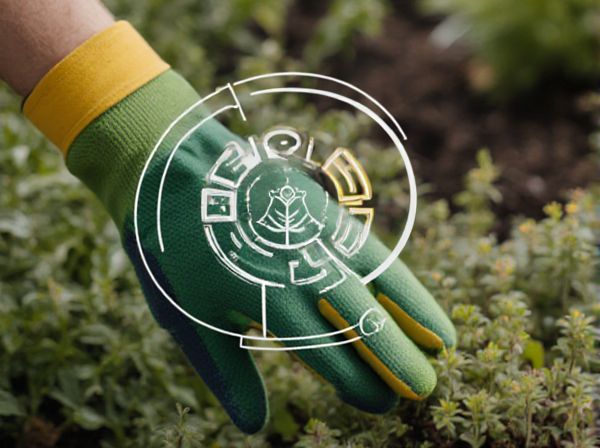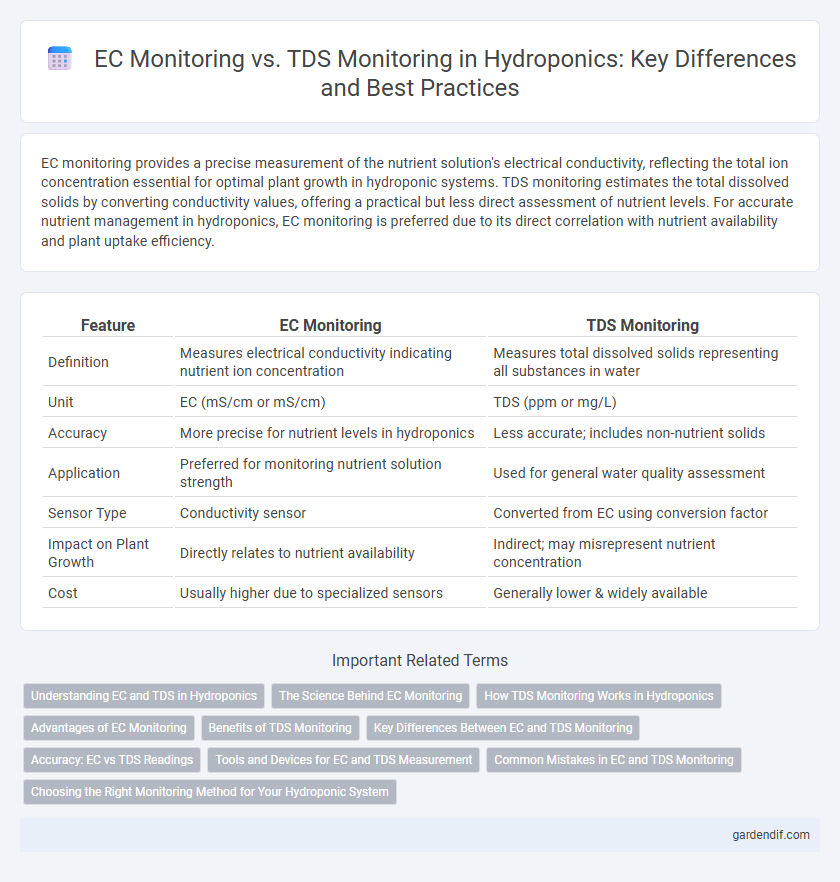
EC Monitoring vs TDS Monitoring Illustration
EC monitoring provides a precise measurement of the nutrient solution's electrical conductivity, reflecting the total ion concentration essential for optimal plant growth in hydroponic systems. TDS monitoring estimates the total dissolved solids by converting conductivity values, offering a practical but less direct assessment of nutrient levels. For accurate nutrient management in hydroponics, EC monitoring is preferred due to its direct correlation with nutrient availability and plant uptake efficiency.
Table of Comparison
| Feature | EC Monitoring | TDS Monitoring |
|---|---|---|
| Definition | Measures electrical conductivity indicating nutrient ion concentration | Measures total dissolved solids representing all substances in water |
| Unit | EC (mS/cm or mS/cm) | TDS (ppm or mg/L) |
| Accuracy | More precise for nutrient levels in hydroponics | Less accurate; includes non-nutrient solids |
| Application | Preferred for monitoring nutrient solution strength | Used for general water quality assessment |
| Sensor Type | Conductivity sensor | Converted from EC using conversion factor |
| Impact on Plant Growth | Directly relates to nutrient availability | Indirect; may misrepresent nutrient concentration |
| Cost | Usually higher due to specialized sensors | Generally lower & widely available |
Understanding EC and TDS in Hydroponics
Electrical Conductivity (EC) measures the ability of a hydroponic nutrient solution to conduct electricity, directly indicating the concentration of available ions essential for plant growth. Total Dissolved Solids (TDS) estimate the combined content of all inorganic and organic substances dissolved in water, providing an approximate measure of nutrient levels but lacking specificity. Accurate EC monitoring ensures precise nutrient management, optimizing plant health, while TDS offers a simpler, less detailed overview of solution strength in hydroponic systems.
The Science Behind EC Monitoring
Electrical Conductivity (EC) monitoring measures the ability of a nutrient solution to conduct electricity, directly correlating with the concentration of ions essential for plant growth in hydroponic systems. Unlike Total Dissolved Solids (TDS) monitoring, which estimates nutrient levels based on a conversion factor and may lack precision, EC monitoring provides more accurate and real-time data about the ionic strength of the solution. This scientific accuracy ensures optimal nutrient availability, preventing deficiencies or toxicities and supporting healthier plant development.
How TDS Monitoring Works in Hydroponics
TDS (Total Dissolved Solids) monitoring in hydroponics measures the concentration of dissolved salts and minerals in the nutrient solution by assessing its electrical conductivity and converting this value using a specific conversion factor. Unlike EC (Electrical Conductivity) monitoring, which directly measures the solution's conductivity to estimate nutrient strength, TDS monitoring provides a more accessible metric reflecting the total ion concentration affecting plant nutrient availability. Maintaining optimal TDS levels ensures balanced nutrient uptake, promoting healthy growth and preventing nutrient imbalances in hydroponic systems.
Advantages of EC Monitoring
EC monitoring provides precise measurement of the nutrient concentration in hydroponic solutions by directly assessing the electrical conductivity, which correlates with ion levels critical for plant growth. It enables real-time adjustments to maintain optimal nutrient balance, improving crop yield and consistency. Unlike TDS monitoring, EC monitoring accounts for the specific conductivity of different ions, offering more accurate control over nutrient availability in hydroponic systems.
Benefits of TDS Monitoring
TDS monitoring provides a direct measurement of the total dissolved solids in a hydroponic solution, offering precise insight into nutrient concentration for optimal plant growth. Unlike EC monitoring, which measures electrical conductivity and can be influenced by water temperature and ion types, TDS readings deliver more standardized data crucial for maintaining balanced nutrient levels. This leads to improved yield consistency and healthier plant development by ensuring nutrients remain within target ranges.
Key Differences Between EC and TDS Monitoring
EC monitoring measures the electrical conductivity of a nutrient solution, directly indicating the concentration of dissolved salts and providing precise control over nutrient levels in hydroponic systems. TDS monitoring estimates the total dissolved solids based on conductivity but uses conversion factors that can vary, leading to less accurate nutrient assessments. The key difference lies in measurement accuracy and reliability, with EC offering real-time, direct data essential for maintaining optimal plant growth conditions.
Accuracy: EC vs TDS Readings
Electrical Conductivity (EC) monitoring offers greater accuracy in measuring nutrient concentration compared to Total Dissolved Solids (TDS) readings because EC directly quantifies the ionic content in the hydroponic solution. TDS meters estimate nutrient levels by converting EC values using a fixed ratio, which can vary significantly depending on the specific nutrient composition, leading to potential inaccuracies. Precise EC measurements ensure optimal nutrient management in hydroponic systems, maximizing plant growth and yield.
Tools and Devices for EC and TDS Measurement
EC monitoring uses conductivity meters designed to measure electrical conductivity, providing accurate insights into nutrient solution strength by detecting ion concentration. TDS monitoring relies on TDS meters that estimate total dissolved solids indirectly, often converting EC values into ppm using specific conversion factors. EC meters tend to offer more precise and consistent readings for hydroponic nutrient management compared to typical TDS meters, which are simpler but less specialized for solution chemistry.
Common Mistakes in EC and TDS Monitoring
Common mistakes in EC and TDS monitoring include relying solely on TDS meters without considering EC values, which provide a more accurate representation of nutrient concentration in hydroponic solutions. Using improperly calibrated sensors leads to inconsistent readings, impacting plant health and growth rates. Ignoring temperature compensation during measurements results in inaccurate data, as EC and TDS values fluctuate with temperature changes in hydroponic systems.
Choosing the Right Monitoring Method for Your Hydroponic System
EC monitoring measures the electrical conductivity of the nutrient solution, providing precise insights into the concentration of dissolved salts essential for optimal plant growth in hydroponic systems. TDS monitoring estimates the total dissolved solids based on conductivity but can be less accurate due to variability in ion types and calibration constants. Selecting EC monitoring ensures more reliable nutrient management, enabling growers to maintain ideal nutrient balance and maximize crop yield in hydroponic setups.
EC Monitoring vs TDS Monitoring Infographic

 gardendif.com
gardendif.com